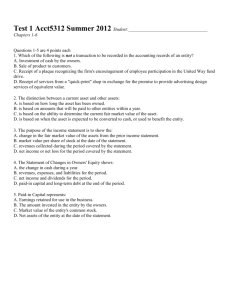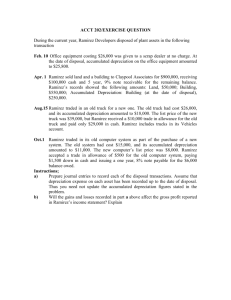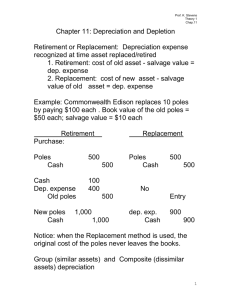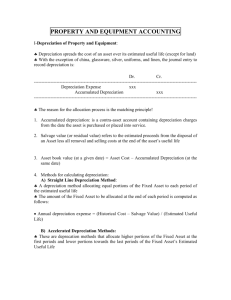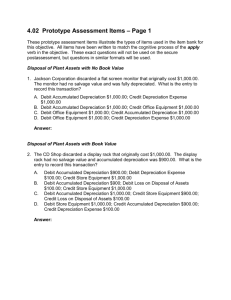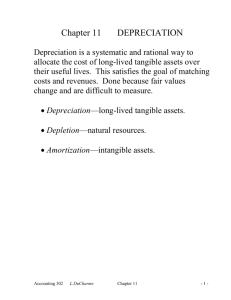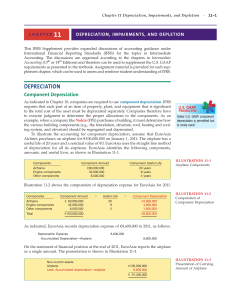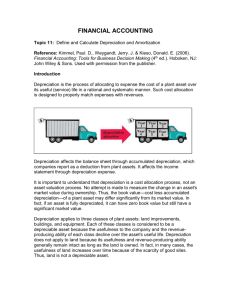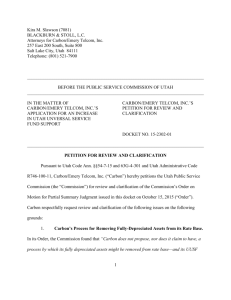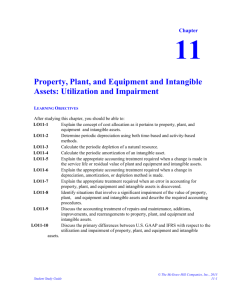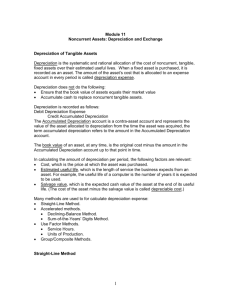HW Chap 11 Day 1
advertisement
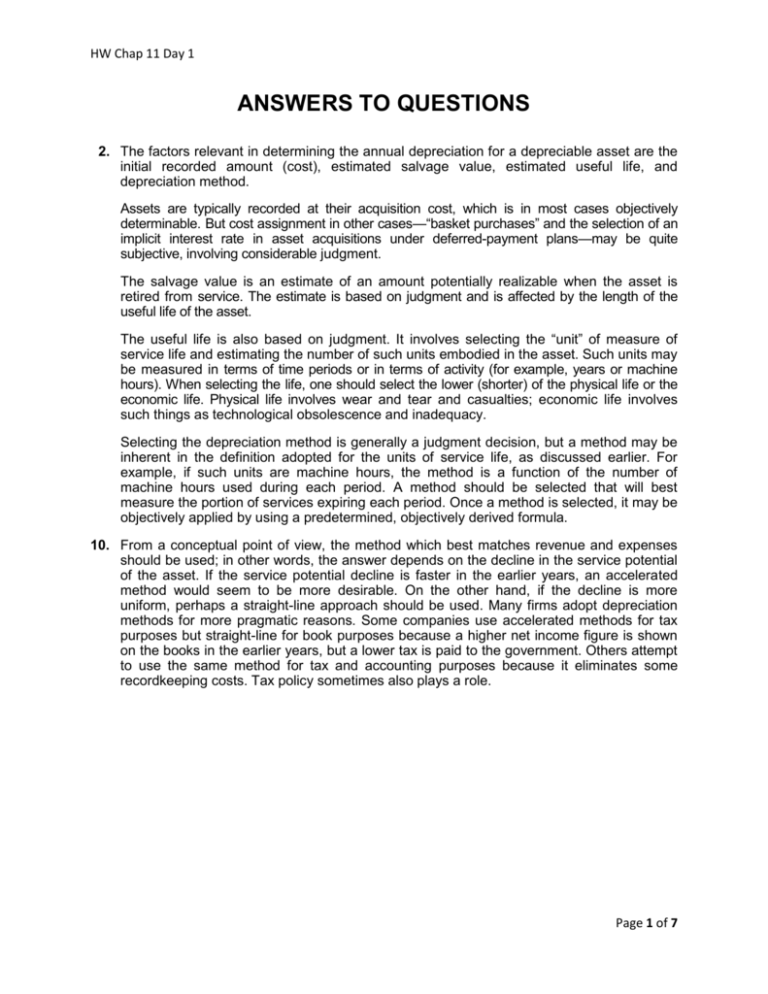
HW Chap 11 Day 1 ANSWERS TO QUESTIONS 2. The factors relevant in determining the annual depreciation for a depreciable asset are the initial recorded amount (cost), estimated salvage value, estimated useful life, and depreciation method. Assets are typically recorded at their acquisition cost, which is in most cases objectively determinable. But cost assignment in other cases—“basket purchases” and the selection of an implicit interest rate in asset acquisitions under deferred-payment plans—may be quite subjective, involving considerable judgment. The salvage value is an estimate of an amount potentially realizable when the asset is retired from service. The estimate is based on judgment and is affected by the length of the useful life of the asset. The useful life is also based on judgment. It involves selecting the “unit” of measure of service life and estimating the number of such units embodied in the asset. Such units may be measured in terms of time periods or in terms of activity (for example, years or machine hours). When selecting the life, one should select the lower (shorter) of the physical life or the economic life. Physical life involves wear and tear and casualties; economic life involves such things as technological obsolescence and inadequacy. Selecting the depreciation method is generally a judgment decision, but a method may be inherent in the definition adopted for the units of service life, as discussed earlier. For example, if such units are machine hours, the method is a function of the number of machine hours used during each period. A method should be selected that will best measure the portion of services expiring each period. Once a method is selected, it may be objectively applied by using a predetermined, objectively derived formula. 10. From a conceptual point of view, the method which best matches revenue and expenses should be used; in other words, the answer depends on the decline in the service potential of the asset. If the service potential decline is faster in the earlier years, an accelerated method would seem to be more desirable. On the other hand, if the decline is more uniform, perhaps a straight-line approach should be used. Many firms adopt depreciation methods for more pragmatic reasons. Some companies use accelerated methods for tax purposes but straight-line for book purposes because a higher net income figure is shown on the books in the earlier years, but a lower tax is paid to the government. Others attempt to use the same method for tax and accounting purposes because it eliminates some recordkeeping costs. Tax policy sometimes also plays a role. Page 1 of 7 HW Chap 11 Day 1 SOLUTIONS TO BRIEF EXERCISES BRIEF EXERCISE 11-1 ($50,000 – $2,000) X 23,000 2012: 160,000 = $6,900 ($50,000 – $2,000) X 31,000 2013: 160,000 = $9,300 BRIEF EXERCISE 11-8 Recoverability test: Future net cash flows ($500,000) < Carrying amount ($520,000); therefore, the asset has been impaired. Journal entry: Loss on Impairment .........................................................120,000 Accumulated Depreciation— Equipment ($520,000 – $400,000) ..................... 120,000 Page 2 of 7 HW Chap 11 Day 1 SOLUTIONS TO EXERCISES EXERCISE 11-3 (15–20 minutes) 20 (20 + 1) (a) 2 = 210 3/4 X 20/210 X ($774,000 – $60,000) = $51,000 for 2012 + 1/4 X 20/210 X ($774,000 – $60,000) = $17,000 3/4 X 19/210 X ($774,000 – $60,000) = 48,450 $65,450 for 2013 100% (b) 20 = 5%; 5% X 2 = 10% 3/4 X 10% X $774,000 = $58,050 for 2012 10% X ($774,000 – $58,050) = $71,595 for 2013 Page 3 of 7 HW Chap 11 Day 1 EXERCISE 11-4 (15–25 minutes) (a) $279,000 – $15,000 = $264,000; $264,000 ÷ 10 yrs. = $26,400 (b) $264,000 ÷ 240,000 units = $1.10; 25,500 units X $1.10 = $28,050 (c) $264,000 ÷ 25,000 hours = $10.56 per hr.; 2,650 hrs. X $10.56 = $27,984 n(n + 1) (d) 10 + 9 + 8 + 7 + 6 + 5 + 4 + 3 + 2 + 1 = 55 OR 2 10(11) = 2 10 55 X $264,000 X 1/3 = $16,000 X $264,000 X 2/3 = 28,800 9 55 Total for 2013 (e) $44,800 $279,000 X 20% X 1/3 = [$279,000 – ($279,000 X 20%)] X 20% X 2/3 = Total for 2013 $18,600 29,760 $48,360 [May also be computed as 20% of ($279,000 – 2/3 of 20% of $279,000)] Page 4 of 7 = 55 HW Chap 11 Day 1 EXERCISE 11-13 (15–20 minutes) (a) $2,400,000 ÷ 40 = $60,000 (b) Loss on Disposal of Plant Assets ..................................90,000 Accumulated Depreciation—Buildings ($180,000 X 20/40) .........................................................90,000 Buildings ................................................................. 180,000 Buildings .......................................................................... 300,000 Cash ........................................................................ 300,000 Note: The most appropriate entry would be to remove the old roof and record a loss on disposal, because the cost of the old roof is given. Another alternative would be to debit Accumulated Depreciation on the theory that the replacement extends the useful life of the building. The entry in this case would be as follows: Accumulated Depreciation—Buildings .......................... 300,000 Cash ........................................................................ 300,000 As indicated, this approach does not seem as appropriate as the first approach. (c) No entry necessary. Page 5 of 7 HW Chap 11 Day 1 EXERCISE 11-13 (Continued) (d) (Assume the cost of the old roof is removed) Building ($2,400,000 – $180,000 + $300,000) ........................ $2,520,000 Accumulated Depreciation ($60,000 X 20 – $90,000) ........... (1,110,000) 1,410,000 Remaining useful life ............................................................. ÷ 25 years Depreciation—2013 ................................................................ $ 56,400 OR (Assume the cost of the new roof is debited to Accumulated Depreciation) Book value of the building prior to the replacement of roof $2,400,000 – ($60,000 X 20) = ...................................... $1,200,000 Cost of new roof ..................................................................... 300,000 $1,500,000 Remaining useful life ............................................................. ÷ 25 years Depreciation—2013 ................................................................ $ 60,000 Page 6 of 7 HW Chap 11 Day 1 EXERCISE 11-18 (15–20 minutes) (a) December 31, 2012 Loss on Impairment ....................................... 220,000 Accumulated Depreciation— Equipment ........................................... 220,000 Note: The asset fails the recoverability test ($300,000 < $500,000) Cost ................................................................. $900,000 Accumulated depreciation ............................. (400,000) Carrying amount ............................................. 500,000 Fair value......................................................... (280,000) Loss on impairment ....................................... $220,000 (b) It may be reported in the other expenses and losses section or it may be highlighted as an unusual item in a separate section. It is not reported as an extraordinary item. (c) No entry necessary. Under GAAP, restoration of any impairment loss is not permitted. (d) Management first had to determine whether there was an impairment. To evaluate this step, management does a recoverability test. The recoverability test estimates the future cash flows expected from use of that asset and its eventual disposition. If the sum of the expected future net cash flows (undiscounted) is less than the carrying amount of the asset, an impairment results. If the recoverability test indicates that an impairment has occurred, a loss is computed. The impairment loss is the amount by which the carrying amount of the asset exceeds its fair value. Page 7 of 7

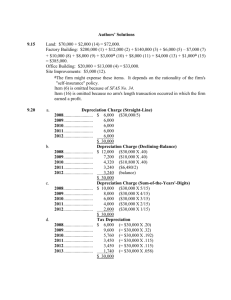


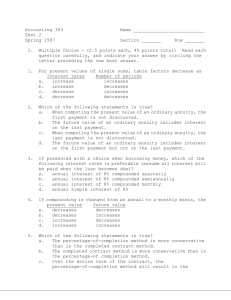
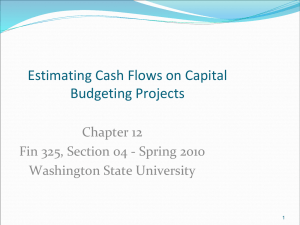
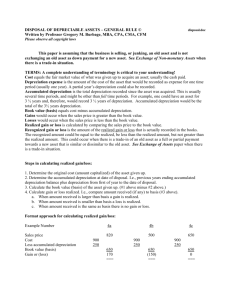
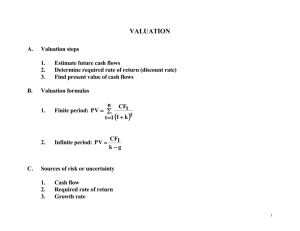

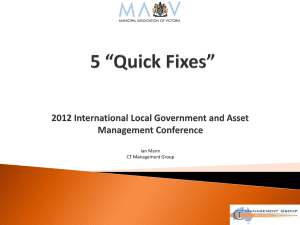
![Quiz chpt 10 11 Fall 2009[1]](http://s3.studylib.net/store/data/005849483_1-1498b7684848d5ceeaf2be2a433c27bf-300x300.png)
